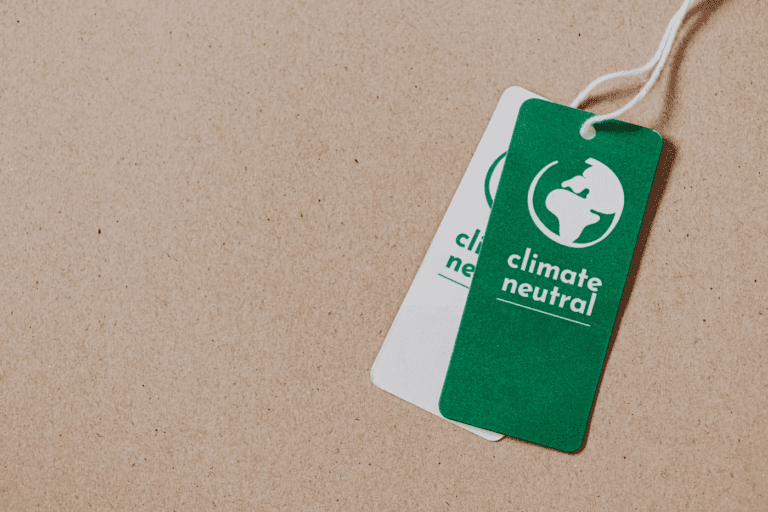We get it, the quest for sustainable protein can feel like navigating a culinary maze. You might ponder, “Can I save the planet and still savor my meals? Is there a way to indulge in eco-conscious feasting without turning into a tree-hugger overnight?“
Fret not, dear reader! We’re here to sprinkle some eco-friendly wisdom on your plate and dish out the tastiest, most sustainable solutions. So, get ready to explore a world where guilt-free, mouthwatering protein sources reign supreme.
Your taste buds and the planet will thank you! 🌱🍔🌎😄
Why Sustainability Matters in Protein
Sustainability isn’t just a buzzword; it’s a compass guiding us towards a healthier planet and a more ethical plate. Let’s dive into the compelling reasons why choosing sustainable protein matters.
Environmental Reasons
- Fight Climate Change: Sustainable protein sources generally have a lower carbon footprint. By reducing greenhouse gas emissions, we contribute to the battle against climate change.
- Protect Biodiversity: Sustainable protein production often involves eco-friendly farming practices that help preserve wildlife habitats and maintain biodiversity.
- Conserve Water: Many sustainable protein sources require less water for cultivation or animal rearing, helping to address the growing global water crisis.
- Preserve Land: Sustainable farming practices use land more efficiently, reducing deforestation and the conversion of natural ecosystems into farmland.
- Reduce Pollution: Sustainable protein sources result in fewer pollutants entering our air and water, leading to cleaner environments.
Ethical Reasons
- Animal Welfare: Sustainable protein options often prioritize the humane treatment of animals, reducing the suffering that can be associated with conventional farming practices.
- Global Food Equity: Sustainable protein sources can potentially provide more equitable access to food resources worldwide, addressing issues of food scarcity and distribution.
- Support Local Communities: Many sustainable protein production methods promote fair wages and local economic development, benefiting communities.
- Long-Term Viability: Sustainability ensures that future generations can access the resources they need for nourishment and a healthy environment.
- Personal Health: Sustainable protein sources often align with healthier diets, contributing to better overall health.
By choosing sustainable protein sources, you’re not just making a meal choice; you’re making a world-changing decision. It’s a win-win for the planet, your conscience, and your taste buds. So, let’s keep our plates green and our hearts light. 🌿🍽️💚
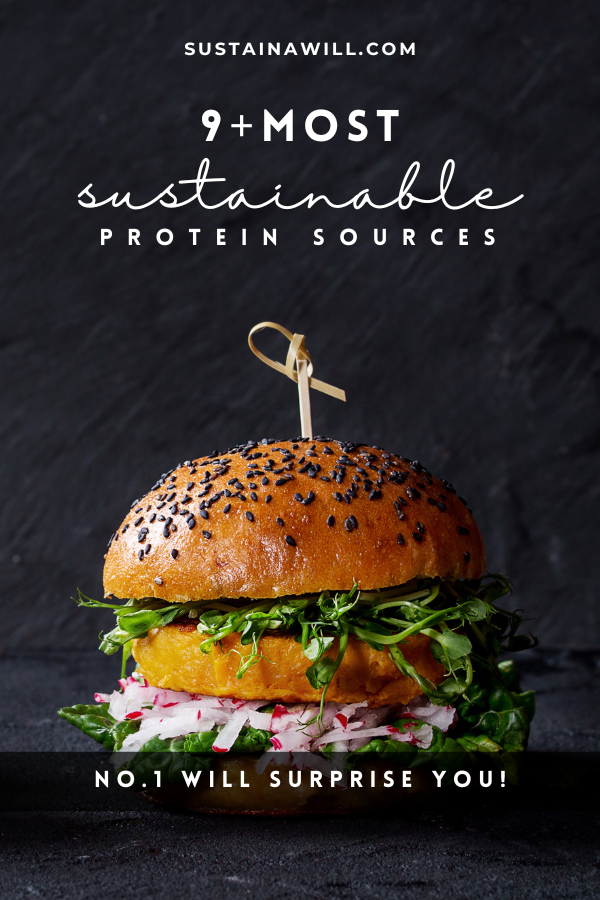
11 Most Sustainable Protein Sources
1. Edible Insects: Low Impact, High Nutrition
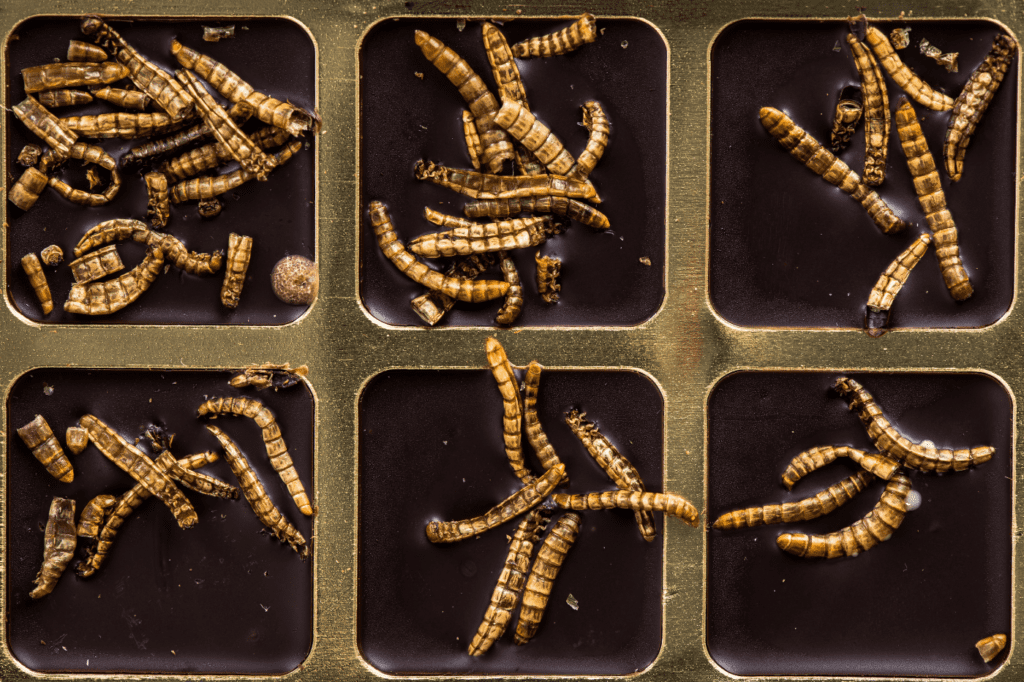
Starting of STROooNGGG. Curious about the buzz around edible insects? You’re in for a treat! Here’s an exploration of their sustainability and why they’re making a big impression on our plates:
Brief Explanation:
Edible insects are exactly what they sound like—bugs you can eat! These critters are a hot topic in the world of sustainable protein, thanks to their remarkably low environmental impact. Insects have gained recognition for their high nutritional value, efficient resource use, and minimal greenhouse gas emissions compared to traditional livestock.
What Makes It Sustainable?
- Minimal Feed Requirements: Insects are incredibly efficient at converting their feed into protein. They require significantly less land, water, and food compared to traditional livestock like cows and pigs.
- Low Emissions: Insects generate fewer greenhouse gases, making them an eco-friendly protein option. Their emissions are a mere fraction of what’s produced by livestock.
- Quick Reproduction: Insects breed rapidly, ensuring a constant and reliable protein source without straining the environment.
- Minimal Water Usage: They consume much less water than traditional livestock, reducing pressure on water resources.
- Versatility: Insects can be cultivated in various environments, from farms to vertical insect gardens, making them adaptable and accessible.
Product Examples
- Cricket Flour: Ground-up crickets are often used to create cricket flour, which can be added to recipes for an extra protein boost. Look for cricket flour in specialty stores and online retailers.
- Roasted Mealworms: Crispy and protein-packed, roasted mealworms are a popular snack in some regions. You can find them in unique snack shops and online.
- Insect Protein Bars: Several companies have introduced protein bars containing insect protein. These bars are designed to be a convenient and sustainable on-the-go snack.
Edible insects might sound unconventional, but their sustainability credentials and nutritional benefits make them a remarkable addition to the sustainable protein landscape. They’re changing the way we think about our protein sources, one bite at a time! 🦗🌿🍽️
2. Algae and Seaweed: The Ocean’s Sustainable Bounty
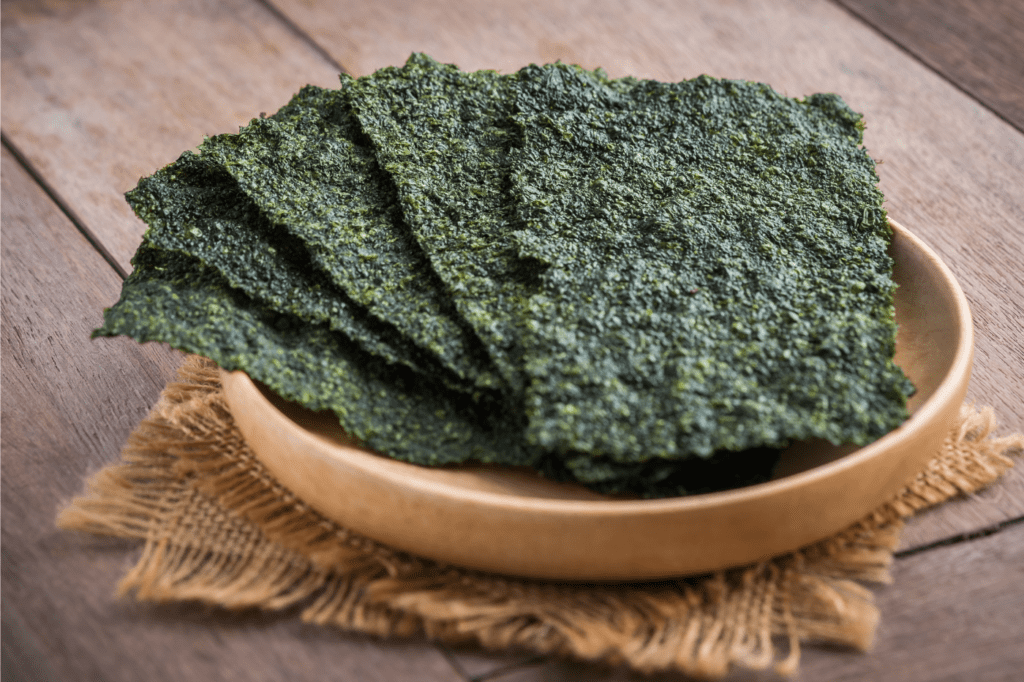
Dive into the deep blue world of algae and seaweed—a hidden treasure in the sustainable protein realm. Let’s explore why they’re making waves for their eco-friendly qualities:
Brief Explanation:
Algae and seaweed might not be your typical protein sources, but they’re making a splash in the sustainability arena. These aquatic wonders are packed with protein and nutrients, all while leaving a minimal environmental footprint. They’re like nature’s green superstars!
What Makes It Sustainable?
- Zero Land Use: Algae and seaweed don’t require land for cultivation, freeing up terrestrial resources for other purposes and reducing deforestation.
- Efficient Growth: They’re incredibly efficient at converting sunlight into energy and protein, making the most of available resources.
- Low Water Consumption: Algae and seaweed thrive in seawater, minimizing freshwater usage and the associated environmental impact.
- Carbon Sequestration: They absorb carbon dioxide, helping to mitigate climate change.
- No Chemicals or Fertilizers: Algae and seaweed can often be cultivated without the need for harmful chemicals or fertilizers.
- Ecosystem Benefits: Sustainable harvesting of these marine plants can promote healthy coastal ecosystems and support biodiversity.
Product Examples
- Spirulina Supplements: Spirulina, a type of blue-green algae, is available in supplement form and is rich in protein and essential nutrients.
- Nori Sheets: Nori, a type of seaweed, is used for making sushi rolls and can be found in most grocery stores.
- Kelp Snacks: Kelp-based snacks, such as kelp chips, are becoming popular for their nutritional content and sustainable sourcing.
- Algae-Based Protein Powders: Some companies offer protein powders made from algae that can be added to smoothies and recipes.
Algae and seaweed are not only good for your health but also for the planet. They demonstrate that the ocean has more to offer than just seafood. So, let’s make a splash and explore the bountiful world beneath the waves! 🌊🌿🍽️
3. Mycoprotein: The Fungi-Based Future of Protein

Get ready to meet the fungi that could change the protein game. Mycoprotein is not only delicious but also incredibly sustainable. Let’s unravel the secrets behind this exciting protein source:
Brief Explanation:
Mycoprotein is a rising star in the world of sustainable protein, and it’s all thanks to its humble fungal origins. Derived from filamentous fungi, mycoprotein offers a protein-rich option that’s both eco-friendly and nutritious. It’s like a fungi-based protein revolution!
What Makes It Sustainable?
- Low Land and Water Use: Mycoprotein production requires less land and water compared to traditional livestock farming, reducing resource consumption.
- Energy-Efficient: The energy requirements for mycoprotein production are lower than those for raising animals, resulting in a reduced carbon footprint.
- Minimal Emissions: Mycoprotein production generates fewer greenhouse gas emissions, contributing to a cleaner environment.
- Recycling Agriculture Waste: Mycoprotein is often cultivated using agricultural waste products, making it a resource-efficient option.
- Reduced Land Conversion: The cultivation of mycoprotein doesn’t contribute to deforestation or the conversion of natural ecosystems into farmland.
- Non-Animal Origin: Mycoprotein is entirely plant-based and doesn’t rely on animal agriculture, reducing the strain on animal welfare and ecosystems.
Product Examples
- Quorn: Quorn is a well-known brand that offers a range of mycoprotein-based products, including meat substitutes, nuggets, and burgers.
- Mycoprotein-Based Sausages: Some food producers create mycoprotein sausages, which are flavorful and sustainable alternatives to traditional meat sausages.
Mycoprotein is not just a smart choice for your health; it’s also a sustainable solution for the planet. It’s proof that the future of protein can be both tasty and eco-conscious. So, let’s give mycoprotein a seat at the table and savor a fungi-based feast! 🍄🌿🍽️
4. Lentils and Pulses: Soil-Enhancing Protein
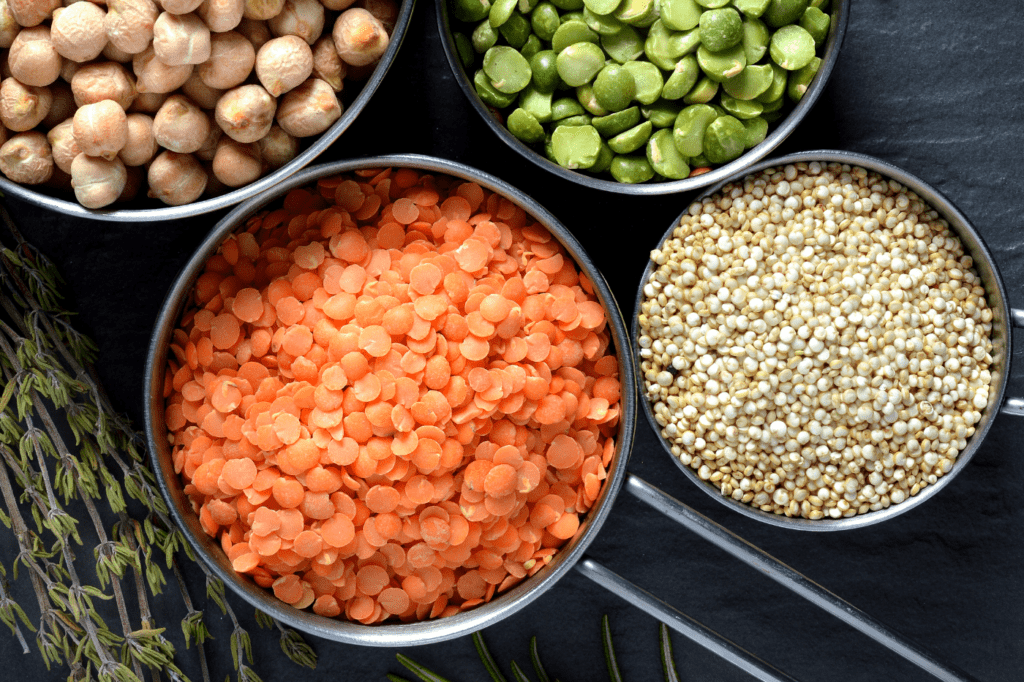
Prepare to be amazed by the mighty legumes! Lentils and pulses are more than just a delicious addition to your plate; they’re key players in soil sustainability. Let’s explore their eco-friendly impact:
Brief Explanation:
Lentils and pulses, including beans, chickpeas, and peas, are not just protein powerhouses; they’re also champions of soil health. Their ability to fix nitrogen and enhance soil quality makes them a sustainable choice that benefits both your diet and the environment.
What Makes It Sustainable?
- Nitrogen Fixation: Lentils and pulses have a unique ability to fix atmospheric nitrogen into a form that plants can use. This process enriches the soil and reduces the need for synthetic fertilizers.
- Reduced Chemical Use: Their natural nitrogen-fixing properties reduce the dependency on chemical fertilizers, which can harm the environment.
- Soil Health: Lentils and pulses improve soil structure, moisture retention, and nutrient availability, promoting long-term soil health.
- Water Efficiency: These crops are typically water-efficient, making them suitable for regions with limited water resources.
- Crop Rotation: They’re often used in crop rotation, preventing soil depletion and maintaining ecosystem diversity.
- Biodiversity: Lentils and pulses contribute to biodiversity by providing habitats for beneficial insects and microorganisms in agricultural fields.
Product Examples
- Lentil Soup: Enjoy a hearty bowl of lentil soup, a delicious way to incorporate lentils into your diet.
- Hummus: Chickpeas, the star ingredient in hummus, are not only tasty but also sustainable.
- Beans and Rice: Classic dishes like beans and rice showcase the sustainability of beans in various culinary traditions.
Lentils and pulses prove that small packages can make a big impact. They’re not just nourishing your body; they’re also nourishing the Earth. So, let’s celebrate these soil-enhancing superheroes in your next meal! 🌱🍽️🌍
5. Pea Protein: A Green Protein Choice
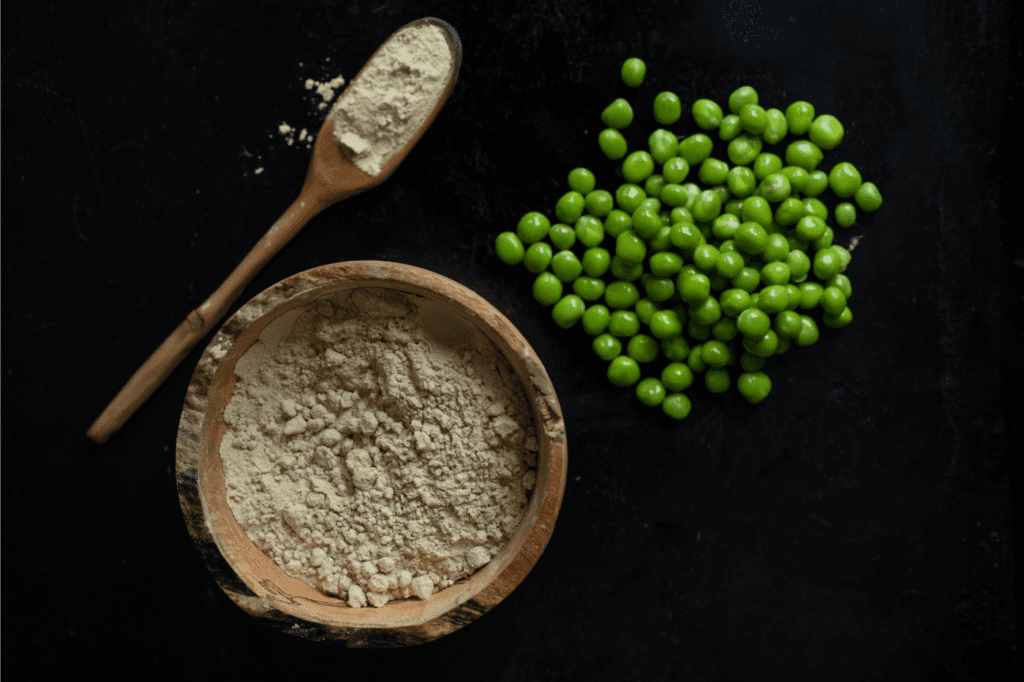
Get ready to explore the unassuming pea’s potential to transform your protein game while keeping things eco-friendly. Let’s dive into the world of pea protein and its sustainability credentials:
Brief Explanation:
Pea protein might be derived from small, unassuming peas, but its sustainability impact is colossal. This green protein option, sourced from nitrogen-fixing peas, not only powers your muscles but also nurtures the environment.
What Makes It Sustainable?
- Nitrogen Fixation: Peas, like other legumes, are nitrogen-fixing plants. They take nitrogen from the air and convert it into a form that enriches the soil, reducing the need for synthetic fertilizers.
- Low Water Usage: Pea crops are typically water-efficient, making them an excellent choice for regions with limited water resources.
- Reduced Carbon Footprint: Pea protein production generates fewer greenhouse gas emissions compared to animal-based protein sources.
- Non-GMO and Non-Allergenic: Many pea protein products are non-GMO and less likely to cause allergies, contributing to a safer and more sustainable food source.
- Diverse Uses: Pea protein can be used in a wide range of food products, from plant-based meat alternatives to protein powders, expanding its sustainable footprint.
Product Examples
- Pea Protein Powder: Pea protein powder is a versatile addition to smoothies and recipes, providing a plant-based protein boost.
- Pea-Based Meat Alternatives: Look for plant-based meat alternatives made with pea protein as a primary ingredient.
- Pea Protein Snacks: Some companies offer pea protein snacks, such as protein bars and chips, as convenient, sustainable snack options.
Pea protein is proof that sustainability can be delicious. It’s a green protein choice that’s as good for the planet as it is for your body. So, let’s make peas, love, and sustainable protein! 🌱🍽️🌎
6. Spirulina and Chlorella: Microalgae’s Sustainable Promise
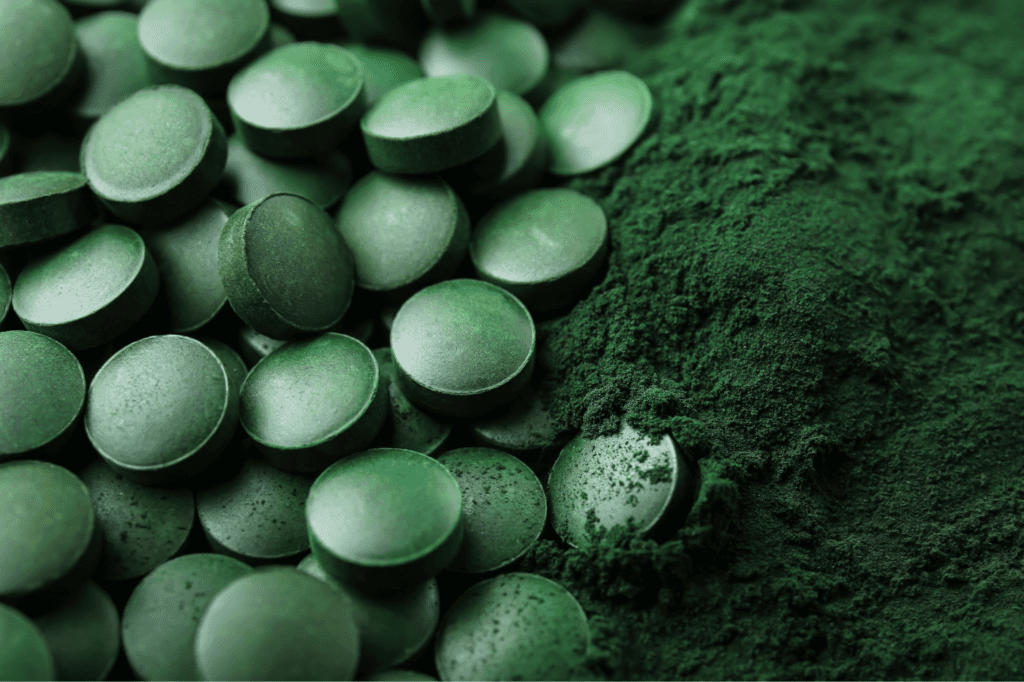
Prepare to be wowed by the tiniest powerhouses of the protein world! Spirulina and chlorella, two remarkable microalgae, aren’t just nutritious but incredibly sustainable. Let’s take a deep dive into the ocean’s green treasures:
Brief Explanation:
Spirulina and chlorella are microalgae, often regarded as nature’s superfoods. They offer not only exceptional nutritional value but also sustainability that’s out of this world. These green wonders are making waves for all the right reasons!
What Makes It Sustainable?
- Efficient Photosynthesis: Spirulina and chlorella are masters of photosynthesis, converting sunlight into energy and protein with remarkable efficiency.
- Minimal Land Use: Cultivated in water, they require minimal land and avoid contributing to deforestation.
- Low Water Consumption: These microalgae thrive in seawater, reducing the demand for freshwater resources.
- Reduced Carbon Footprint: The carbon emissions associated with their cultivation are considerably lower compared to traditional livestock.
- High Yields: Spirulina and chlorella offer high protein yields in a small footprint, ensuring efficient resource use.
- Nutrient Density: They are rich in essential nutrients, making them a sustainable protein source that benefits your health.
Product Examples
- Spirulina and Chlorella Supplements: Spirulina and chlorella supplements are available in various forms, such as tablets, powders, and capsules, making it easy to incorporate them into your diet.
- Spirulina and Chlorella Smoothie Additions: You can boost your smoothies and recipes with spirulina and chlorella powders, adding a sustainable protein punch.
- Spirulina Snacks: Some companies offer spirulina-based snacks like energy bars for a nutrient-rich and eco-conscious snack.
Spirulina and chlorella prove that even the tiniest organisms can have a significant impact. They’re not just green; they’re incredibly clean and sustainable. So, let’s embrace these microalgae for a healthier you and a healthier planet! 🌿🍽️🌊
7. Plant-Based Proteins: A Green Alternative

Let’s venture into the vibrant world of plant-based proteins—a diverse and sustainable protein landscape. Join us as we explore the sustainability of these green alternatives:
Brief Explanation:
Plant-based proteins are the champions of sustainability, offering a wide range of eco-friendly options that not only enrich your diet but also help reduce the environmental footprint. From legumes to grains, they are paving the way for a greener future.
What Makes It Sustainable?
- Low Environmental Impact: Plant-based proteins generally have a lower carbon footprint compared to animal-based protein sources.
- Reduced Land Use: They require less land for cultivation, reducing the need for deforestation and land conversion.
- Lower Water Consumption: Many plant-based crops are water-efficient, conserving this precious resource.
- Biodiversity Preservation: Sustainable plant-based agriculture can promote biodiversity and protect ecosystems.
- Reduced Chemical Use: Organic and sustainable farming practices minimize the use of harmful chemicals and pesticides.
- Versatility: Plant-based proteins come in various forms, allowing for creative and eco-conscious cooking.
Product Examples
- Tofu: Tofu is a versatile soy-based protein that can be used in a wide range of dishes, from stir-fries to desserts.
- Lentils: Lentils are not only nutritious but also eco-friendly, making them a staple in many vegetarian and vegan diets.
- Quinoa: Quinoa is a protein-rich grain that’s highly sustainable and can be used in salads, bowls, and more.
- Chickpeas: Chickpeas, a versatile legume, are the key ingredient in dishes like hummus and falafel.
- Beyond Meat: Brands like Beyond Meat offer plant-based meat alternatives that are delicious and sustainable.
- Plant-Based Milk: Almond, soy, and oat milk are sustainable alternatives to dairy milk, reducing the environmental impact of the dairy industry.
Plant-based proteins are not just a dietary choice; they’re a conscious decision to support a more sustainable future. These green alternatives offer endless possibilities for eco-conscious and delicious meals. So, let’s embrace the abundance of plant-based options and savor the flavors of sustainability! 🌱🍽️🌍
8. Cultured or Lab-Grown Meat: The Potential for Sustainable Protein
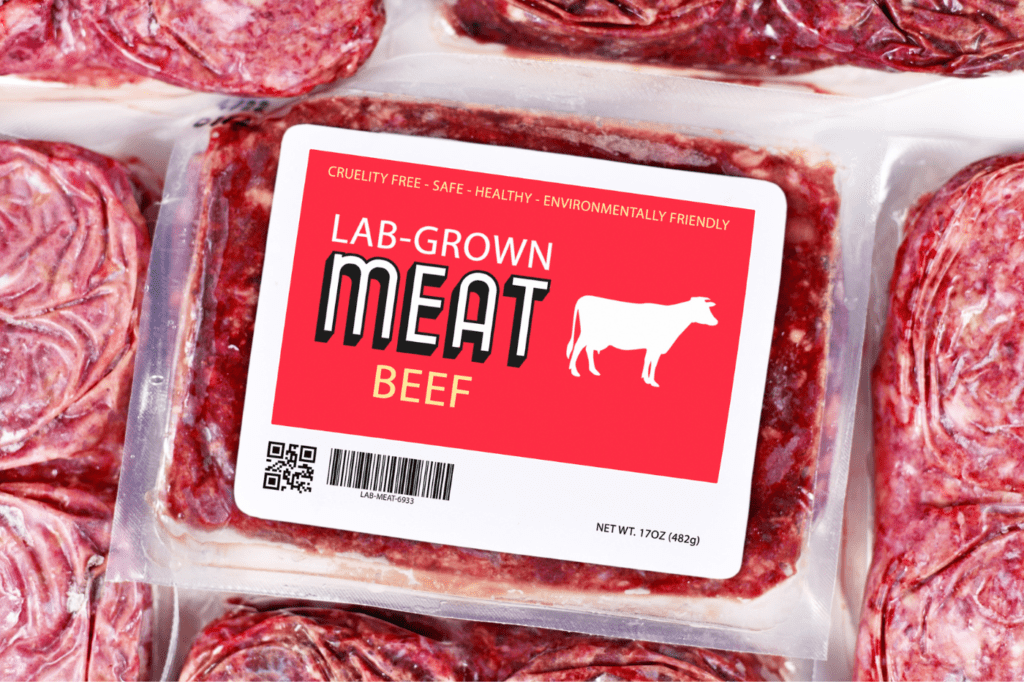
Let’s embark on a futuristic journey into the world of lab-grown meat—a sustainable protein option that’s raising eyebrows and hopes. Explore the potential sustainability of this innovative protein source:
Brief Explanation:
Cultured or lab-grown meat is not science fiction; it’s a reality with the promise of reducing the environmental impact of traditional livestock farming. This technology is opening doors to a more sustainable future of protein production.
What Makes It Sustainable?
- Lower Carbon Emissions: Lab-grown meat has the potential to produce fewer greenhouse gas emissions compared to conventional livestock farming.
- Reduced Land Use: It requires significantly less land, helping to preserve natural ecosystems and reduce deforestation.
- Efficient Resource Use: Cultured meat can be produced with greater resource efficiency, including water and feed.
- Ethical Considerations: It addresses ethical concerns related to animal welfare by eliminating the need for traditional livestock farming.
- Healthier Production: Lab-grown meat has the potential to be produced in controlled environments with reduced use of antibiotics and chemicals.
Product Examples
- Lab-Grown Burgers: Some companies have made headlines by producing lab-grown burgers, showcasing the potential of this technology.
- Cultured Chicken: Lab-grown chicken products are in development, aiming to offer sustainable alternatives to traditional poultry.
- Cultured Seafood: Cultured seafood, such as lab-grown fish, promises to be a more sustainable choice for seafood lovers.
While lab-grown meat is still in its early stages, it holds promise for a more sustainable future of protein production. By exploring this innovative technology, we are taking steps toward reducing the environmental impact of our protein choices and addressing ethical concerns in the meat industry. 🧪🍖🌱
9. Nut and Seed Proteins: Sourcing Sustainability
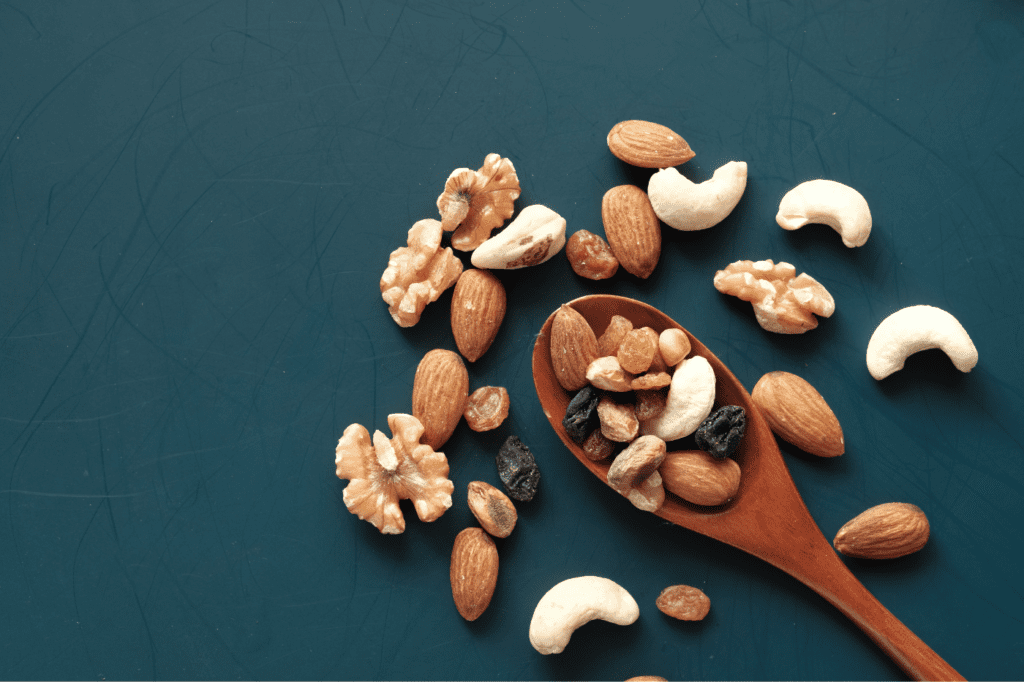
Get ready to uncover the potential of nuts and seeds as sustainable protein sources. These plant-based powerhouses have a lot to offer, so let’s delve into their eco-friendly impact:
Brief Explanation:
Nuts and seeds, often found in your kitchen or as delicious snacks, can also be a sustainable source of protein when sourced responsibly. They offer a world of possibilities for nutritious and eco-conscious eating.
What Makes It Sustainable?
- Minimal Land Use: Nuts and seeds require relatively small amounts of land for cultivation, reducing the pressure for deforestation and land conversion.
- Lower Water Consumption: Many nut and seed crops are water-efficient, making them suitable for regions with limited water resources.
- Diverse Ecosystems: Responsible nut and seed farming can promote biodiversity and maintain ecosystems.
- Local Economic Benefits: Sustainable nut and seed production can provide economic opportunities for local communities.
- Plant-Based and Versatile: Nuts and seeds are entirely plant-based, making them suitable for a wide range of dietary preferences and culinary applications.
Product Examples
- Almonds: Almonds are a popular source of plant-based protein, often consumed as a snack or in various dishes.
- Chia Seeds: Chia seeds are known for their nutritional content and can be used in smoothies, puddings, and baked goods.
- Peanuts: Peanuts, in addition to being a snack, are used to make peanut butter and add protein to dishes.
- Sunflower Seeds: Sunflower seeds can be a crunchy snack or a topping for salads and yogurt.
- Pistachios: These nuts are not just delicious but also contribute to sustainable agriculture.
Nuts and seeds show that even small packages can have a big impact on sustainability. They are versatile, and delicious, and offer a sustainable protein choice that benefits both you and the environment. So, let’s celebrate these nutrient-packed gems in your meals! 🌰🍽️🌍
10. Seitan: The Wheat-Based Protein

Time to meet seitan—a wheat-based protein source that’s been a dietary staple in some cultures for centuries. Let’s explore the world of seitan and its sustainability, with a focus on responsible wheat production:
Brief Explanation:
Seitan, often called “wheat meat” or “wheat gluten,” is a protein-rich meat substitute with deep roots in various cuisines. It’s not just a versatile ingredient; it can also be a sustainable choice when produced with environmentally responsible wheat.
What Makes It Sustainable?
- Plant-Based Protein: Seitan is entirely plant-based, reducing the reliance on animal agriculture and its associated environmental impact.
- Efficient Wheat Use: Wheat is a widely grown crop, and utilizing it to create seitan can be a sustainable way to make the most of available resources.
- Diverse Culinary Uses: Seitan’s versatility means it can replace meat in various dishes, promoting plant-based eating.
- Responsible Wheat Production: Sustainable seitan production involves sourcing wheat from farms that practice responsible agriculture, including reduced chemical usage and soil conservation.
- Supports Local Economies: Supporting local wheat farmers can contribute to regional economic development.
Product Examples
- Seitan Strips: You can find seitan in various forms, including strips that can be used in stir-fries, sandwiches, and salads.
- Seitan Sausages: Seitan sausages offer a meatless alternative that’s perfect for grilling and adding to your favorite dishes.
- Seitan Roasts: Some companies create seitan roasts, perfect for holiday or celebratory meals.
Seitan is proof that plant-based protein can be hearty, flavorful, and sustainable. By choosing seitan, you’re not only satisfying your taste buds but also making a positive environmental impact. So, let’s give seitan a try and savor the wheat-based wonders of this protein source! 🌾🍽️🌎
Choosing Sustainable Protein: Tips for Consumers

Ready to tackle the protein world with an eco-friendly twist? Here’s your cheat sheet for making sustainable protein choices that’ll impress your taste buds and Mother Earth:
10 Amazing Tips for Incorporating Sustainable Protein
1. Embrace “Plants are Cool” Days: Make certain days of the week all about plant-based protein. Beans, lentils, and nuts are like the superheroes of the plant kingdom, and they’re here to save the planet, one meal at a time.
2. Be a Local Foodie: It’s time to flirt with your local farmers’ market. Support the neighborhood food scene and reduce your food’s carbon footprint by keeping it close to home.
3. Label Love: Be a label detective and look for sustainability certifications on your favorite products. The more badges, the better. It’s like giving your meal a green thumbs-up.
4. Waste Not, Want Not: Plan your meals like you’re hosting a dinner party for your favorite characters. Get creative with leftovers, and your fridge will be the star of its very own cooking show.
5. Channel Your Inner Marine Biologist: If seafood is your jam, swim toward sustainably sourced options. It’s like sending a lifeguard to the ocean while you feast like a pro.
6. Brand Loyalty: Stick with brands that put their heart (and their ethical practices) into their products. When in doubt, let your wallet speak for you.
7. Dare to Be Deliciously Different: Don’t be afraid to be the food adventurer you were born to be. Lab-grown meat, edible insects, and microalgae are your passport to a world of culinary excitement.
8. Show Plastic Who’s Boss: Reduce your single-use plastic usage. Opt for products that come in packaging that won’t outlast the pyramids. You and the planet will breathe a little easier.
9. Shout from the (Dinner) Tabletops: Share your sustainable journey with your foodie friends and family. Become the sustainability superhero you were meant to be and turn your dinner table into a talk show.
Conclusion: A Sustainable Protein Future
Ladies and gentlemen, as we reach the grand finale of our protein-packed adventure, it’s time to reflect on the delightful path we’ve traveled. We’ve learned that sustainable protein choices are about making a statement, one plate at a time.
Your conscious choices have a ripple effect—like tossing a pebble into a pond, creating ever-expanding circles of positive change. By embracing plant-based wonders, supporting local producers, and championing responsible brands, you’re not just filling your belly; you’re nurturing a healthier planet.
In the grand tapestry of your meals, every ingredient tells a story—a story of sustainable living, ethical choices, and a brighter future. So, remember that while you’re nourishing your body, you’re also nourishing the Earth. And that, my friends, is a beautiful harmony of flavors and values that will leave a lasting legacy.
As you move forward, continue to explore new tastes, experiment with eco-friendly options, and share your sustainable journey with others. Let’s transform every dining experience into an opportunity for change, turning forks into mighty tools for a greener world.
Bon appétit and here’s to a sustainable protein future that’s as delightful as it is responsible. 🌱🍽️🌍








